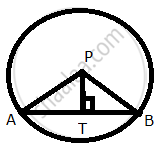Advertisements
Advertisements
प्रश्न
Find the values of y for which the distance between the points P (2, -3) and Q (10, y) is 10 units.
उत्तर १
PQ = `sqrt((x_2 - x_1)^2 + (y_2 - y_1)^2)`
⇒ `sqrt((10 - 2)^2 + (y + 3)^2) = 10`
⇒ (8)2 + (y + 3)2 = 100
⇒ 64 + y2 + 6y + 9 = 100
⇒ y2 + 6y + 73 - 100 = 0
⇒ y2 + 6y - 27 = 0
⇒ y2 + 9y - 3y - 27 = 0
⇒ y(y + 9) - 3(y + 9) = 0
⇒ (y + 9) (y - 3) = 0
⇒ y + 9 = 0
⇒ y = -9
and y - 3 = 0
⇒ y = 3
उत्तर २
The distance d between two points `(x_1, y_1)` and `(x_2, y_2)` is given by the formula
d = `sqrt((x_1-x_2)^2 + (y_1 - y_2)^2)`
The distance between two points P(2,−3) and Q(10,y) is given as 10 units. Substituting these values in the formula for distance between two points, we have,
10 = `sqrt((2 - 10)^2 + (-3 - y)^2)`
Now, squaring the above equation on both sides of the equals sign
100 = (-8)2 + (-3 - y)2
100 = 64 + 9 + y2 + 6y
27 = y2 + 6y
Thus, we arrive at a quadratic equation. Let us solve this now.
y2 + 6y - 27 = 0
y2 + 9y - 3y - 27 = 0
y(y + 9) - 3(y + 9) = 0
(y - 3) (y + 9) = 0
The roots of the above quadratic equation are thus 3 and −9.
Thus, the value of ‘y’ could either be 3 or -9.
संबंधित प्रश्न
If the point (x, y) is equidistant from the points (a + b, b – a) and (a – b, a + b), prove that bx = ay
Show that four points (0, – 1), (6, 7), (–2, 3) and (8, 3) are the vertices of a rectangle. Also, find its area
Name the type of quadrilateral formed, if any, by the following point, and give reasons for your answer:
(−3, 5), (3, 1), (0, 3), (−1, −4)
Two opposite vertices of a square are (-1, 2) and (3, 2). Find the coordinates of other two
vertices.
Find the distance between the points
(ii) A(7,-4)and B(-5,1)
Find the distance between the following pair of point.
T(–3, 6), R(9, –10)
Find the distance between the following pair of point in the coordinate plane.
(1 , 3) and (3 , 9)
Find the distance between the following point :
(Sin θ - cosec θ , cos θ - cot θ) and (cos θ - cosec θ , -sin θ - cot θ)
Prove that the following set of point is collinear :
(5 , 1),(3 , 2),(1 , 3)
Find the coordinate of O , the centre of a circle passing through A (8 , 12) , B (11 , 3), and C (0 , 14). Also , find its radius.
ABC is an equilateral triangle . If the coordinates of A and B are (1 , 1) and (- 1 , -1) , find the coordinates of C.
Show that the points P (0, 5), Q (5, 10) and R (6, 3) are the vertices of an isosceles triangle.
The centre of a circle is (2x - 1, 3x + 1). Find x if the circle passes through (-3, -1) and the length of its diameter is 20 unit.
Point P (2, -7) is the centre of a circle with radius 13 unit, PT is perpendicular to chord AB and T = (-2, -4); calculate the length of AB.

If the point (x, y) is at equidistant from the point (a + b, b – a) and (a-b, a + b). Prove that ay = bx.
Find distance between point A(7, 5) and B(2, 5)
The distance between the points A(0, 6) and B(0, -2) is ______.
The point which lies on the perpendicular bisector of the line segment joining the points A(–2, –5) and B(2, 5) is ______.
A circle has its centre at the origin and a point P(5, 0) lies on it. The point Q(6, 8) lies outside the circle.
A point (x, y) is at a distance of 5 units from the origin. How many such points lie in the third quadrant?
